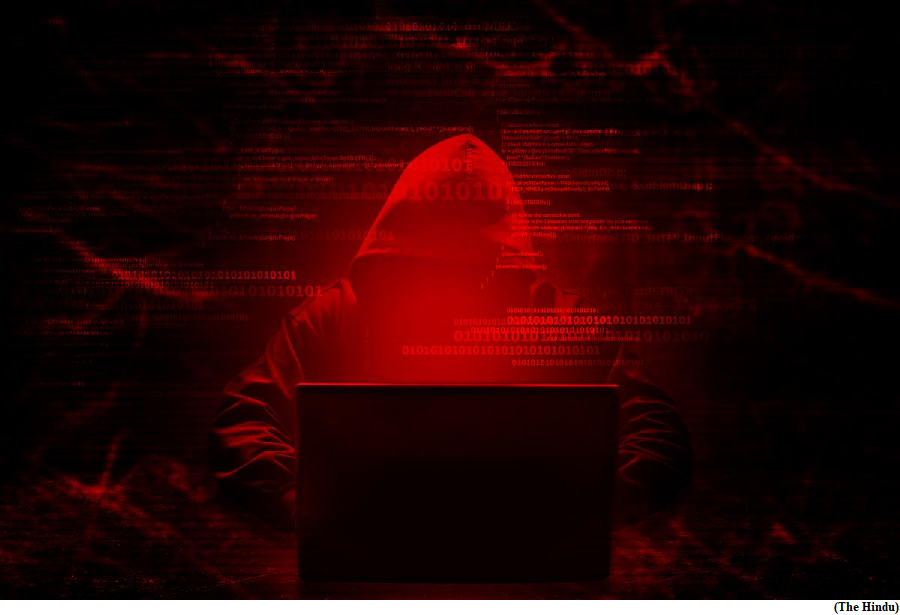Cyberattacks are rising, but there is an ideal patch (GS Paper 3, Science and Tech)

Context:
- The frequency and targets of cyberattacks on India are becoming increasingly serious.
- With cyber threats capable of undermining our critical infrastructure, industry and security, a comprehensive cyber security policy is the need of the hour.
Why it matters?
- The recent incidents have highlighted the soft underbelly of our fast expanding digital networks. The first was the ransomware attack on the servers of India’s premium institute, the All India Institute of Medical Sciences. Nearly 40 million health records were compromised and it took over two weeks for the systems to be brought online.
- Soon afterwards, a ransomware gang, BlackCat, breached the parent company of Solar Industries Limited, one of the Ministry of Defence’s ammunition and explosives manufacturers, and extracted over 2 Terabyte of data.
Growing vulnerability:
- Ransomwares have emerged as the most predominant of malicious cyberattacks. Here, the perpetrators demand hefty payments for the release of withheld data. Data show that over 75% of Indian organisations have faced such attacks, with each breach costing an average of ₹35 crore of damage.
- There are other malwares that could infect all kinds of computer systems. With the lines between the physical and digital realms blurring rapidly, every critical infrastructure, from transportation, power and banking systems, would become extremely vulnerable to the assaults from hostile state and non-state actors.
- Cyber capabilities are also playing a pivotal role, as seen in the ongoing conflict in Ukraine, where electronic systems in warheads, radars and communication devices have reportedly been rendered ineffective using hacking and GPS jamming.
Policy framework in place:
- In 2022, the Indian Computer Emergency Response Team (CERT-In), which is India’s cybersecurity agency, introduced a set of guidelines for organisations to comply with when connected to the digital realm.
- This included the mandatory obligation to report cyberattack incidents within hours of identifying them, and designating a pointsperson with domain knowledge to interact with CERT-In.
- India’s draft Digital Personal Protection Bill 2022 proposes a penalty of up to ₹500 crore for data breaches.
- Recently, India’s armed forces created a Defence Cyber Agency (DCyA), capable of offensive and defensive manoeuvres.
Challenges:
- All Indian States have their own cyber command and control centres. India also faces an acute scarcity of cybersecurity professionals. India is projected to have a total workforce of around 3,00,000 people in this sector in contrast to the 1.2 million people in the United States.
- Most of our organisations are in the private sector, and their participation remains limited in India’s cybersecurity structures. They would be advised to look at the Digital Geneva Convention, where over 30 global companies have signed a declaration to protect users and customers from cyber breaches, and collaborate with like-minded intergovernmental and state frameworks.
- With the introduction of 5G and the arrival of quantum computing, the potency of malicious software, and avenues for digital security breaches would only increase. India’s cybersecurity strategy would do well not to overlook these actualities and trends.
Global collaborations:
- With most cyberattacks originating from beyond our borders, international cooperation would be critical to keep our digital space secure. It would also be a cause which would find resonance abroad.
- In 2023, cybercrimes are expected to cause damage worth an estimated $8 trillion worldwide. India has already signed cybersecurity treaties, where the countries include the United States, Russia, the United Kingdom, South Korea and the European Union.
- Even in multinational frameworks such as the Quad and the I2U2 (which India is a member of) there are efforts to enhance cooperation in cyber incident responses, technology collaboration, capacity building, and in the improvement of cyber resilience. Yet, there is no truly global framework, with many operating in silos.
Steps by UNGA:
- Previous years have seen the United Nations General Assembly establish two processes on the issues of security in the information and communication technologies (ICT) environment.
- One is the Open-ended Working Group (OEWG), comprising the entire UN membership, established through a resolution by Russia.
- The other is the resolution by the U.S., on the continuation of the Group of Governmental Experts (GGE), comprising 25 countries from all the major regions.
- The two antagonistic permanent members of the UN Security Council, counted among India’s most important strategic partners, differ vastly on many aspects of the Internet, including openness, restrictions on data flow, and digital sovereignty.
- Yet, based on adoption, member-states have found the two resolutions to be complementary, and not mutually exclusive. Amidst the turbulent current world events, these UN groups would struggle to have effective dialogues.
Way Forward:
- The G-20 summit 2023 in India, which will see participation by all the stakeholders driving the global levers of power, is a rare opportunity to bring together domestic and international engagement groups across the spectrum, and steer the direction of these consultations.
- India could make an effort to conceptualise a global framework of common minimum acceptance for cybersecurity. This would be one of the most significant contributions made by any nation towards collective security in modern times.


